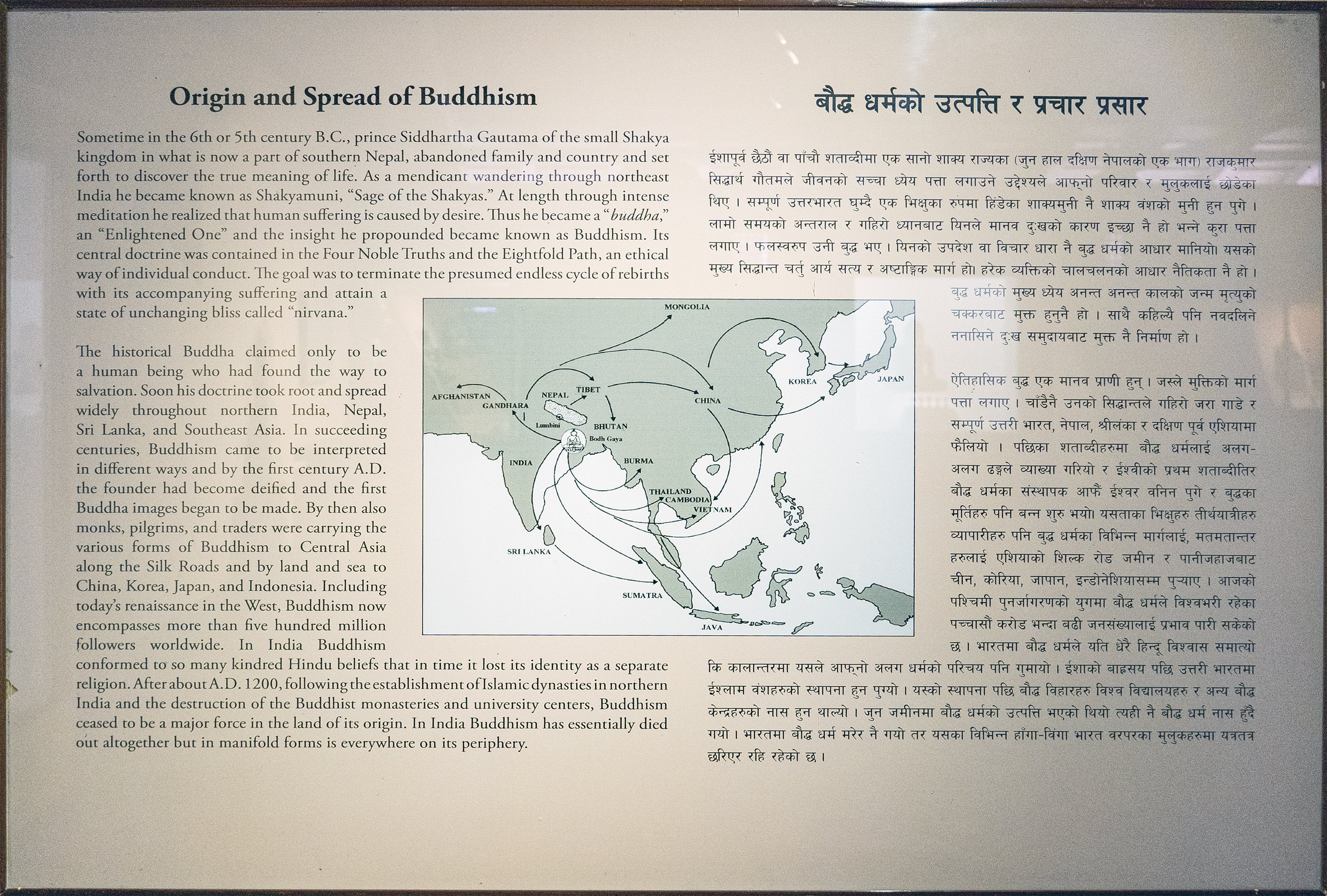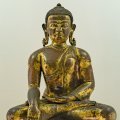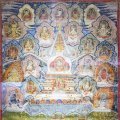Patan Museum (Nepal): photo 116
Photo 116 of 212 in Gallery: Patan Museum (Nepal)

Image title: Origin and Spread of Buddhism
Description of the photo
Origin and Spread of Buddhism—Sometime in the 6th or 5th century B.C., prince Siddhartha Gautama of the small Shakya kingdom in what is now a part of southern Nepal, abandoned family and country and set forth to discover the true meaning of life. As a mendicant wandering through northeast India he became known as Shakyamuni, “Sage of the Shakyas.” At length through intense meditation he realized that human suffering is caused by desire. Thus he became a “buddha” an “Enlightened One” and the insight he propounded became known as Buddhism. Its central doctrine was contained in the Four Noble Truths and the Eightfold Path, an ethical way of individual conduct. The goal was to terminate the presumed endless cycle of rebirths with its accompanying suffering and attain a state of unchanging bliss called “nirvana.”
The historical Buddha claimed only to be a human being who had found the way to salvation. Soon his doctrine took root and spread Widely throughout northern India, Nepal, Sri Lanka, and Southeast Asia. In succeeding centuries, Buddhism came to be interpreted in different ways and by the first century A.D. the founder had become deified and the first Buddha images began to be made. By then also monks, pilgrims, and traders were carrying the various forms of Buddhism to Central Asia along the Silk Roads and by land and sea to China, Korea, Japan, and Indonesia. Including todays renaissance in the West, Buddhism now encompasses more than five hundred million followers worldwide. In India Buddhism conformed to so many kindred Hindu beliefs that in time it lost its identity as a separate religion. After about A.D. 1200, following the establishment of Islamic dynasties in northern India and the destruction of the Buddhist monasteries and university centers. Buddhism ceased to be a major force in the land of its origin. In India Buddhism has essentially died out altogether but in manifold forms is everywhere on its periphery.
Nepalese text (not proofread):
बौद्ध धर्मको उत्पत्ति र प्रचार प्रसार—ईशापूर्व छैठौं वा पांचौ शताब्दीमा एक सानो शाक्य राज्यका (जुन हाल दक्षिण नेपालको एक भाग) राजकुमार सिद्धार्थ गौतमले जीवनको सच्चा ध्येय पत्ता लगाउने उद्देश्यले आफ्नो परिवार र मुलुकलाई छोडेका थिए। सम्पूर्ण उत्तरभारत घुम्दै एक भिक्षुका रुपमा हिडेका शाक्यमुनी नै शाक्य वंशको मुनी हुन पुगे । लामो समयको अन्तराल र गहिरो ध्यानबाट यिनले मानव दुःखको कारण इच्छा नै हो भन्ने कुरा पत्ता लगाए । फलस्वरुप उनी बुद्ध भए । यिनको उपदेश वा विचार धारा नै बुद्ध धर्मको आधार मानियो। यसको मुख्य सिद्धान्त चतुर्आर्य सत्य र अष्टाङ्गिक मार्ग हो। हरेक व्यक्तिको चालचलनको आधार नैतिकता नै हो । बुद्ध धर्मको मुख्य ध्येय अनन्त अनन्त कालको जन्म मृत्युको चक्करबाट मुक्त हुनुनै हो । साथै कहिल्यै पनि नबदलिने ननासिने दुःख समुदायबाट मुक्त नै निर्माण हो।
अइतिहासिक बुद्ध एक मानव प्राणी हुन् । जस्ले मुक्तिको मार्ग पत्ता लगाए । चाडैनै उनको सिद्धान्तले गहिरो जरा गाडे र सम्पूर्ण उत्तरी भारत, नेपाल, श्रीलंका र दक्षिण पूर्व एशियामा फैलियो । पछिका शताब्दीहरुमा बौद्ध धर्मलाई अलग- अलग ढङ्गले व्याख्या गरियो र ईश्वीको प्रथम शताब्दीतिर बौद्ध धर्मका संस्थापक आफै ईश्वर वनिन पुगे र बुद्धका मूर्तिहरु पनि बन्न शुरु भयो। यसताका भिक्षुहरु तीर्थयात्रीहरु व्यापारीहरु पनि बुद्ध धर्मका विभिन्न मार्गलाई, मतमतान्तर हरुलाई एशियाको शिल्क रोड जमीन र पानीजहाजबाट चीन, कोरिया, जापान, इन्डोनेशियासम्म पुन्याए । आजको पश्चिमी पुनर्जागरणको युगमा बौद्ध धर्मले विश्वभरी रहेका पच्चासौ करोड भन्दा बढी जनसंख्यालाई प्रभाव पारी सकेको छ । भारतमा बौद्ध धर्मले यति धेरै हिन्दू विश्वास समात्यो कि कालान्तरमा यसले आफ्नो अलग धर्मको परिचय पनि गुमायो । ईशाको बाह्रसय पछि उत्तरी भारतमा ईश्लाम वंशहरुको स्थापना हुन पुग्यो । यस्को स्थापना पछि बौद्ध विहारहरु विश्व विद्यालयहरु र अन्य बौद्ध केन्द्रहरुको नास हुन थाल्यो । जुन जमीनमा बौद्ध धर्मको उत्पत्ति भएको थियो त्यही नै बौद्ध धर्म नास हुँदै गयो । भारतमा बौद्ध धर्म मरेर नै गयो तर यसका विभिन्न हांगा-विंगा भारत वरपरका मुलुकहरूमा यत्रतत्र छरिएर रहि रहेको छ ।
English translation (automated):
Origin and Propagation of Buddhism - In the sixth or fifth century BC, Prince Siddhartha Gautama of a small Sakya kingdom (now a part of southern Nepal) left his family and country to find the true purpose of life. Shakyamuni who traveled all over North India as a monk became the ruler of the Shakya dynasty. Through long periods of time and deep meditation, he discovered that desire is the cause of human suffering. As a result, he became a Buddha. His teachings or thoughts were considered the basis of Buddhism. Its main principles are the fourfold truth and the eightfold path. Ethics is the basis of every person's behavior. The main goal of Buddhism is to be free from the cycle of eternal birth and death. In addition, it is a construction free from the community of sorrow that will never change.
The prehistoric Buddha is a human being. Who discovered the way to salvation. Soon his doctrine took deep roots and spread throughout North India, Nepal, Sri Lanka and South East Asia. In later centuries, Buddhism was interpreted in different ways, and around the first century AD, the founder of Buddhism became God himself, and statues of Buddha also began to be made. Its monks, pilgrims, merchants also brought different paths of Buddhism, different opinions, from Asia's Silk Road by land and sea to China, Korea, Japan, Indonesia. In today's era of western renaissance, Buddhism has influenced more than 500 million people around the world. Buddhism in India took hold of Hindu beliefs so much that over time it lost its identity as a separate religion. After the 12th century AD, Islamic dynasties were established in northern India. After its establishment, Buddhist monasteries, universities and other Buddhist centers began to be destroyed. In the land where Buddhism originated, Buddhism was destroyed. Buddhism died out in India but its various branches are still scattered in the countries around India.
Transcription:
Bauddha dharmako utpatti ra pracāra prasāra—īśāpūrva chaiṭhauṃ vā pāṃcau śatābdīmā eka sāno śākya rājyakā (juna hāla dakṣiṇa nepālako eka bhāga) rājakumāra siddhārtha gautamale jīvanako saccā dhyeya pattā lagāune uddeśyale āphno parivāra ra mulukalāī choḍekā thie. Sampūrṇa uttarabhārata ghumdai eka bhikṣukā rupamā hiḍekā śākyamunī nai śākya vaṃśako munī huna puge . Lāmo samayako antarāla ra gahiro dhyānabāṭa yinale mānava duḥkhako kāraṇa icchā nai ho bhanne kurā pattā lagāe . Phalasvarupa unī buddha bhae . Yinako upadeśa vā vicāra dhārā nai buddha dharmako ādhāra māniyo. Yasako mukhya siddhānta caturārya satya ra aṣṭāṅgika mārga ho. Hareka vyaktiko cālacalanako ādhāra naitikatā nai ho . Buddha dharmako mukhya dhyeya ananta ananta kālako janma mṛtyuko cakkarabāṭa mukta hununai ho . Sāthai kahilyai pani nabadaline nanāsine duḥkha samudāyabāṭa mukta nai nirmāṇa ho.
aitihāsika buddha eka mānava prāṇī hun . Jasle muktiko mārga pattā lagāe . Cāḍainai unako siddhāntale gahiro jarā gāḍe ra sampūrṇa uttarī bhārata, nepāla, śrīlaṃkā ra dakṣiṇa pūrva eśiyāmā phailiyo . Pachikā śatābdīharumā bauddha dharmalāī alaga- alaga ḍhaṅgale vyākhyā gariyo ra īśvīko prathama śatābdītira bauddha dharmakā saṃsthāpaka āphai īśvara vanina puge ra buddhakā mūrtiharu pani banna śuru bhayo. Yasatākā bhikṣuharu tīrthayātrīharu vyāpārīharu pani buddha dharmakā vibhinna mārgalāī, matamatāntara harulāī eśiyāko śilka roḍa jamīna ra pānījahājabāṭa cīna, koriyā, jāpāna, inḍoneśiyāsamma punyāe . Ājako paścimī punarjāgaraṇako yugamā bauddha dharmale viśvabharī rahekā paccāsau karoḍa bhandā baḍhī janasaṃkhyālāī prabhāva pārī sakeko cha . Bhāratamā bauddha dharmale yati dherai hindū viśvāsa samātyo ki kālāntaramā yasale āphno alaga dharmako paricaya pani gumāyo . Īśāko bāhrasaya pachi uttarī bhāratamā īślāma vaṃśaharuko sthāpanā huna pugyo . Yasko sthāpanā pachi bauddha vihāraharu viśva vidyālayaharu ra anya bauddha kendraharuko nāsa huna thālyo . Juna jamīnamā bauddha dharmako utpatti bhaeko thiyo tyahī nai bauddha dharma nāsa huṃdai gayo . Bhāratamā bauddha dharma marera nai gayo tara yasakā vibhinna hāṃgā-viṃgā bhārata varaparakā mulukaharūmā yatratatra chariera rahi raheko cha .
Transcription:
bauddha dharmako utpatti ra pracara prasara—ishapurva chaithaum va pamcau shatabdima eka sano shakya rajyaka (juna hala dakshina nepalako eka bhaga) rajakumara siddhartha gautamale jivanako sacca dhyeya patta lagaune uddeshyale aphno parivara ra mulukalai chodeka thie. sampurna uttarabharata ghumdai eka bhikshuka rupama hideka shakyamuni nai shakya vamshako muni huna puge . lamo samayako antarala ra gahiro dhyanabata yinale manava duhkhako karana iccha nai ho bhanne kura patta lagae . phalasvarupa uni buddha bhae . yinako upadesha va vicara dhara nai buddha dharmako adhara maniyo. yasako mukhya siddhanta caturarya satya ra ashtangika marga ho. hareka vyaktiko calacalanako adhara naitikata nai ho . buddha dharmako mukhya dhyeya ananta ananta kalako janma mrityuko cakkarabata mukta hununai ho . sathai kahilyai pani nabadaline nanasine duhkha samudayabata mukta nai nirmana ho.
aitihasika buddha eka manava prani hun . jasle muktiko marga patta lagae . cadainai unako siddhantale gahiro jara gade ra sampurna uttari bharata, nepala, shrilamka ra dakshina purva eshiyama phailiyo . pachika shatabdiharuma bauddha dharmalai alaga- alaga dhangale vyakhya gariyo ra ishviko prathama shatabditira bauddha dharmaka samsthapaka aphai ishvara vanina puge ra buddhaka murtiharu pani banna shuru bhayo. yasataka bhikshuharu tirthayatriharu vyapariharu pani buddha dharmaka vibhinna margalai, matamatantara harulai eshiyako shilka roda jamina ra panijahajabata cina, koriya, japana, indoneshiyasamma punyae . ajako pashcimi punarjagaranako yugama bauddha dharmale vishvabhari raheka paccasau karoda bhanda badhi janasamkhyalai prabhava pari sakeko cha . bharatama bauddha dharmale yati dherai hindu vishvasa samatyo ki kalantarama yasale aphno alaga dharmako paricaya pani gumayo . ishako bahrasaya pachi uttari bharatama ishlama vamshaharuko sthapana huna pugyo . yasko sthapana pachi bauddha viharaharu vishva vidyalayaharu ra anya bauddha kendraharuko nasa huna thalyo . juna jaminama bauddha dharmako utpatti bhaeko thiyo tyahi nai bauddha dharma nasa humdai gayo . bharatama bauddha dharma marera nai gayo tara yasaka vibhinna hamga-vimga bharata varaparaka mulukaharuma yatratatra chariera rahi raheko cha .
Gallery information:
The Patan Museum is located on the Durbar square of Patan (Lalitpur/Lalitapura, Kathmandu, Nepal) which is associated Keshav Narayan Chowk (Keshavnarayan)—a form of Lord Vishnu. Being listed as a World Heritage Site, the whole of Durbar square is filled with exquisite temples, sculptures and other ancient structures, of which the ancient history history can be traced to the Malla Kings of Lalitpur. It is an important site for both Buddhism and Hinduism.
Photo details:
Date: 2019-12-02
Camera: SONY ILCE-6400
Exposure: 1/160
Aperture: f/4
ISO: 1600
Focal length: 18mm
High resolution:
Download file
Size: 3.66 MB
Resolution: 2962 x 2000
© Photograph by Gabe Hiemstra.
License: CC BY-NC-ND 4.0

